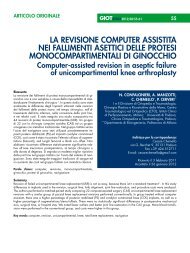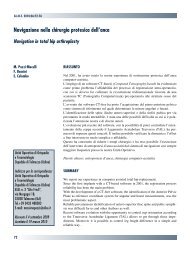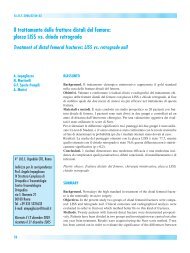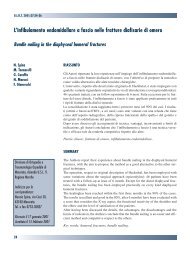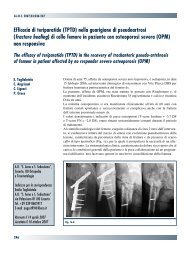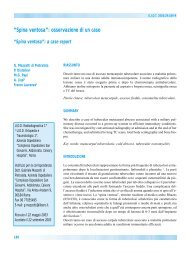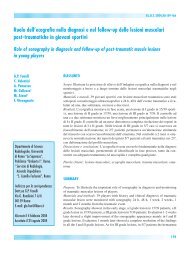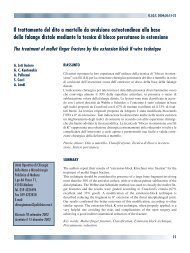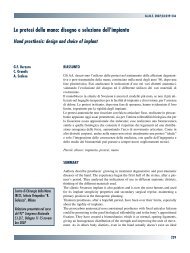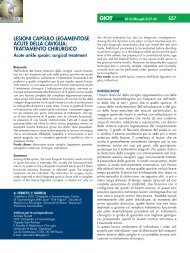30845 Suppl Giot.pdf - Giornale Italiano di Ortopedia e Traumatologia
30845 Suppl Giot.pdf - Giornale Italiano di Ortopedia e Traumatologia
30845 Suppl Giot.pdf - Giornale Italiano di Ortopedia e Traumatologia
Create successful ePaper yourself
Turn your PDF publications into a flip-book with our unique Google optimized e-Paper software.
artroscopia d’anca<br />
La <strong>di</strong>agnosi clinica è legata prevalentemente alla dolorabilità palpatoria;<br />
gli esami ra<strong>di</strong>ografici sono generalmente negativi e sono<br />
utili ad escludere altre patologie dell’anca; in rare occasioni possono<br />
essere presenti calcificazioni peritrocanteriche; in tali situazioni<br />
può essere fatta <strong>di</strong>agnosi <strong>di</strong> borsite calcifica; calcificazioni peritrocanteriche<br />
possono essere più spesso presenti in esiti dolorosi <strong>di</strong><br />
artroprotesi <strong>di</strong> anca.<br />
Nella maggior parte dei casi la sindrome viene trattata in maniera<br />
incruenta con terapia me<strong>di</strong>ca, fisica o infiltrativa, con alta percentuale<br />
<strong>di</strong> risoluzione: nei casi recalcitranti, e soprattutto nei casi <strong>di</strong><br />
calcificazioni peritrocanteriche, può essere eseguito il trattamento<br />
chirurgico <strong>di</strong> bursectomia: il trattamento endoscopico va consigliato<br />
per gli ovvi vantaggi della mini-invasività della meto<strong>di</strong>ca 21 .<br />
La bursectomia endoscopica consente la rimozione della borsa e<br />
delle eventuali calcificazioni.<br />
TENDINOPaTIE DI MEDIO E PICCOLO GLuTEO<br />
I ten<strong>di</strong>ni me<strong>di</strong>o e piccolo gluteo si inseriscono sul gran trocantere<br />
e formano una struttura simile alla cuffia dei rotatori della spalla.<br />
Lesioni ten<strong>di</strong>nee a questo livello vengono definite le “lesioni della<br />
cuffia dei rotatori dell’anca” e possono avere aspetti clinici ed<br />
anatomo-patologici <strong>di</strong>fferenti.<br />
Si tratta <strong>di</strong> patologie piuttosto frequenti, ma che sono poco conosciute<br />
e quin<strong>di</strong> poco <strong>di</strong>agnosticate.<br />
I sintomi consistono in dolore in corrispondenza delle inserzione<br />
dei ten<strong>di</strong>ni al gran trocantere, con accentuazione del dolore e<br />
<strong>di</strong>fficoltà all’abduzione dell’anca; all’esame obiettivo vi è dolore<br />
all’extrarotazione contro resistenza con anca flessa a 90°, dolore e<br />
facile stancabilità in appoggio monopodalico.<br />
L’esame ra<strong>di</strong>ografico è generalmente negativo, può mostrare<br />
iniziali manifestazioni artrosiche che non giustificano il dolore<br />
presente, raramente può evidenziare la presenza <strong>di</strong> microcalcificazioni<br />
in corrispondenza dell’inserzione ten<strong>di</strong>nea dei glutei al gran<br />
trocantere.<br />
La presenza <strong>di</strong> lesioni ten<strong>di</strong>nee può essere confermata da una ecografia<br />
o da una RMN.<br />
Il quadro clinico può simulare quello <strong>di</strong> una semplice borsite<br />
trocanterica, ma è generalmente resistente alla terapia me<strong>di</strong>ca ed<br />
infiltrativa che in questi casi viene eseguita.<br />
Le possibili calcificazioni possono essere rimosse per via endoscopica<br />
22 .<br />
Le lesioni ten<strong>di</strong>nee dei glutei possono essere evidenziate e trattate<br />
per via endoscopica me<strong>di</strong>ante reinserzione con ancore al gran<br />
trocantere 23 .<br />
CONCLuSIONI<br />
L’applicazione della tecnica artroscopica nella patologia dell’anca<br />
rappresenta l’ultima frontiera delle tecnica mini-invasive in ortope<strong>di</strong>a<br />
e si ritiene che tale meto<strong>di</strong>ca abbia gran<strong>di</strong> prospettive nel trattamento<br />
delle lesioni descritte e che possa contribuire ad una miglio-<br />
S248<br />
re valutazione delle patologie d’anca ed ad un sempre più definito<br />
ed efficace trattamento. Sebbene sia una chirurgia impegnativa<br />
e non scevra da complicanze, il miglioramento della <strong>di</strong>agnostica<br />
strumentale, l’affinamento della tecnica e la più precisa conoscenza<br />
delle patologie interessate ci fanno ritenere che l’artroscopia d’anca<br />
sarà nei prossimi anni oggetto <strong>di</strong> una sempre maggiore attenzione e<br />
<strong>di</strong>ffusione tra i chirurghi ortope<strong>di</strong>ci.<br />
BIBLIOGraFIa<br />
1 Kelly BT, Buly RL. Hip Arthroscopy Update. HSSJ 2005;1:40-48.<br />
2 Khanduja V, Villar RN. Arthroscopic surgery of the hip. Current concepts<br />
and recent advances. J Bone Joint Surg Br 2006;88:1557-66.<br />
3 Smart LR, Oetgen M, Noonan B, et al. Beginning Hip Arthroscopy:<br />
In<strong>di</strong>cations, Positioning, Portals, Basic Techniques, and Complications.<br />
Arthroscopy 2007;23:1348-53.<br />
4 Tibor LM, Sekiya JK. Differential Diagnosis of Pain Around the Hip Joint.<br />
Arthroscopy 2008;24:1407-21.<br />
5 Byrd JWT, Jones KS. Hip arthroscopy in athletes. Clin Sports Med<br />
2001;20(4):749-62.<br />
6 Lage LA, Patel JV, Villar RN. The acetabular labral tear: an arthroscopic<br />
classification. Arthroscopy 1996;12:269-72.<br />
7 Kelly BT, Weiland DE, Schenker ML, et al. Arthroscopic labral repair<br />
in the hip: surgical technique and review of the literature. Arthroscopy<br />
2005;21:1496-504.<br />
8 McCarthy JC. Hip arthroscopy: when it is and when it is not in<strong>di</strong>cated. Instr<br />
Course Lect 2004;53:615-21.<br />
9 Ruch DS, Sekiya J, Dickson Schaefer W, et al. The role of hip arthroscopy<br />
in the evaluation of avascular necrosis. Orthope<strong>di</strong>cs 2001;24:339-43.<br />
10 Sekiya JK, Ruch DS, Hunter DM, et al. Hip arthroscopy in staging<br />
avascular necrosis of the femoral head. J South Orthop Assoc 2000;9:254-<br />
61.<br />
11 Byrd JWT, Jones KS. Microfrafracture for grade IV Chondral lesions of the<br />
hip. Arthroscopy 2004;20:SS89,41.<br />
12 Krebs VE. The role of hip arthroscopy in the treatment of synovial <strong>di</strong>sorders<br />
and loose bo<strong>di</strong>es. Clin Orthop Relat Res 2003;406:48-59.<br />
13 Boyer T, Dorfmann H. Arthroscopy in primary synovial chondromatosis<br />
of the hip: description and outcome of treatment. J Bone Joint Surg Br<br />
2008;90(3):314-8.<br />
14 Gray AJ, Villar RN. The ligamentum teres of the hip: an arthroscopic<br />
classification of its pathology. Arthroscopy 1997;13:575-8.<br />
15 McCarthy JC, Jibodh SR, Lee JA. The role of arthroscopy in evaluation of<br />
painful hip arthroplasty. Clin Orthop Relat Res 2009;467(1):174-80.<br />
16 Dorfmann H, Boyer T. Hip arthroscopy utilizing the supine position.<br />
Arthroscopy.1996;12(2):264-7.<br />
17 Pitto RP, Klaue K, Ganz R, et al. Acetabular rim pathology secondary to<br />
congenital hip dysplasia in the adult. A ra<strong>di</strong>ographic study. Chir Organi<br />
Mov 1995;80(4):361-8.<br />
17 Futami T, Kasahara Y, Suzuki S, et al. Arthroscopy for slipped capital<br />
femoral epiphysis. J Pe<strong>di</strong>atr Orthop 1992;12:592-7.<br />
19 Byrd JWT. Evaluation and management of the snapping iliopsoas tendon.<br />
Instr Course Lect 2006;55:347-55.<br />
20 Wettstein M, Jung J, Dienst M. Arthroscopic psoas tenotomy. Arthroscopy<br />
2006;22(8):907:e1-4.<br />
21 Voos JE, Ranawat AS, Kelly BT. The peritrochanteric space of the hip. Instr<br />
Course Lect 2009;58:193-201.<br />
22 Kandemir U, Bharam S, Phillippon MJ, et al. Endoscopic treatment of<br />
calcific ten<strong>di</strong>nitis of gluteus me<strong>di</strong>us and minimus. Arthroscopy 2003;19:E4.<br />
23 Voos JE, Shindle MK, Pruett A, et al. Endoscopic repair of gluteus me<strong>di</strong>us<br />
tendon tears of the hip. Am J Sports Med 2009;37(4):743-7.



